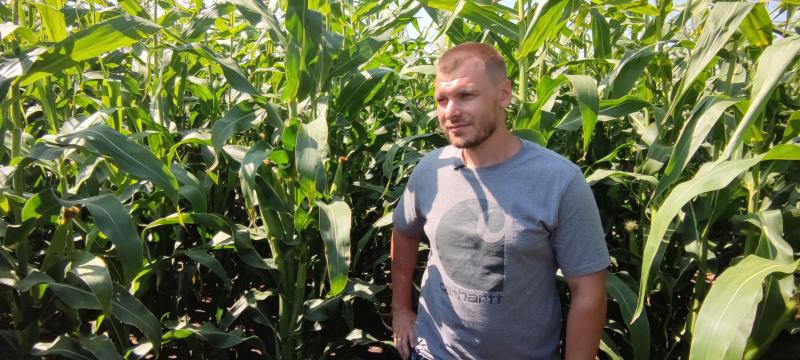
An agronomist from Ukraine with a 10-year experience in agriculture said that there are many more incentives to switch to intensive irrigation in Kazakhstan than in Ukraine. Andrey Khomenko, an agronomist from Kusto Farming, clearly demonstrated to a World of NAN reporter the benefits of irrigation, how to harvest high yields and what surprised him.
This year's drought has affected most farmers in Kazakhstan. Kusto Farming was not spared by the disaster either. In the village of Mamai, the organization grows corn for silage for the fattening of the multiplier. Out of 900 hectares, only 200 hectares are artificially irrigated. It is obvious even to the naked eye where the corn was irrigated. If on the irrigated part the corn grew over 2 meters in height, the plants barely reached one meter on the rainfed part. The drought is merciless!
"Here we grow proven KAZSEEDS hybrids. Selectionist Edward Baumgartner bred them specifically for the conditions of northern Kazakhstan. Under conditions of drought, the hybrids have performed well. However, this year we had critically low precipitation during the growing season, and you can see the result," explained Andrey Khomenko.
According to him, the company focuses on the vegetative mass, and by improving the quality of irrigation, plans to get more crops. As such this year it was planned to harvest about 15 tons of silage per hectare at the rainfed area, and for irrigation - 40 tons. But the drought has made adjustments and time will tell how much will be collected at the rainfed area.
This year's drought has clearly demonstrated the advantage of artificial irrigation. According to the agronomist, Kazakhstan has created favorable conditions for the transition to intensive irrigation of the fields.
"There is a lot of support from the state in Kazakhstan. Local farmers can get subsidies for sprinkler machines and infrastructure facilities (pumping stations, pipelines, power lines, etc.). In addition, irrigation water is many times cheaper than, for example, in Ukraine. It is necessary to use all these advantages while they are available. Of course, there are disadvantages too. There are problems with water sources. Here we need state investment in construction of expensive infrastructure, such as: irrigation canals, reservoirs, water storages," - said the agronomist from Ukraine.
Andrei's words are supported by the fact that Kusto Farming is planning to increase the irrigated area up to 700 hectares at its subdivision in Mamai village. This will allow them to get a stable result from the fields and provide the multiplier with fodder. However, these are not the only tools that help get good results. The farm uses weather stations, moisture sensors and software that makes it possible to understand when to start irrigating and at what rate it should be done.
"Irrigation is a tool that, even in a dry year, makes it possible to get a decent result. But it is important to understand that this is not the only thing a farmer should provide, first of all it is important to choose the right hybrids, to determine the optimal sowing time for the region, it is important to know the soil composition. That is, how much nitrogen, phosphorus, potassium, and other nutrients it contains", - shared his knowledge agronomist.
Andrew added that this year on the fields of Mamai village there have been sown two hybrids with different FAO 260 and 350, to determine which hybrid will receive a high yield in the silage. In addition, an experimental field was also created in the village of Malika Gabdulina, Akmola region (formerly Pukhalskoye), where 15 hybrids of corn of different producers were sown, and an experiment with the timing of sowing, density of standing and mineral nutrition system was laid.
"We want to collect the necessary information on various hybrids. If we talk about the current state of the demo plot, KAZSEEDS hybrids show good results and are on a par with well-known, proven global brands. Particularly surprising is the hybrid "Aliya", we are guaranteed to get her in the grain. It is ahead of other hybrids and should give products earlier, which is critical for us because of the short frost-free period in the NKR and Akmola region. With so much precipitation I thought the situation would be much worse, "- said about the experimental field of Andrey Khomenko.
Asked whether the company plans to replace hybrids with "Alia", the head of KAZSEEDS Serik Ramazanov said that this will be decided after the harvest, when developing the technological map for next year. But in any case it will be not only "Aliya", other hybrids will also be used in the cropping structure, as there should always be a diversification of hybrids.
The World of NAN editorial promises to follow the results on the experimental field and pass on the information.












































Обсуждение